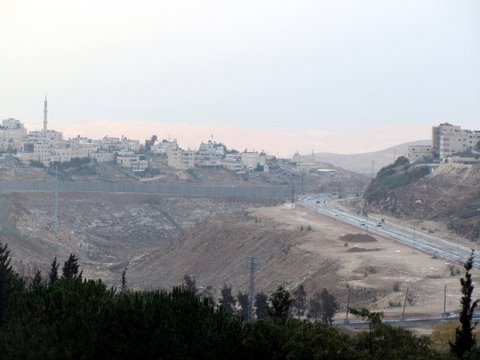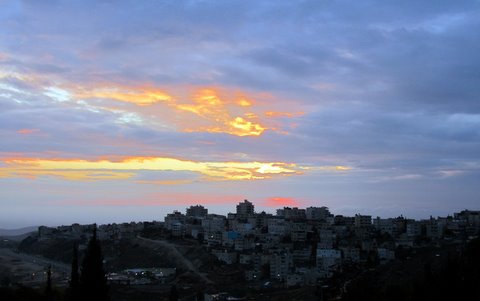By Ira Sharkansky

JERUSALEM — A rainy weekend leads me to thoughts about climate.
This is a note about my locality, not about the fate of the world.
Perhaps some of you thought I was living in the desert.
Not true. Jerusalem has almost as much rain on an annual basis as London. An umbrella is useless here from April through October. A rain in those months produces media headlines. When it does rain from November through March, it is not like a light London mist manageable with an umbrella. It is often heavy and comes with wind that makes an umbrella more of a burden than a benefit.
Jerusalem and especially the eastern suburbs like French Hill are on the wet side of the desert’s border. While the city gets an average rainfall of 554 mm (against London’s 650 mm), a bit more than 10 miles further east the average ranges between 30 and 150 mm annually. http://www.ims.gov.il/IMS/CLIMATE
Before the first intifada that began in the late 1980s, we could drive to Jericho is the midst of a wet winter and enjoy lunch in an outdoor restaurant, under a grape arbor that shielded us from the sun. Imagine Miami a half hour by car from Manhattan and you get the message.
Among our oddities is a continental divide only a block to the west. On the other side of Hahagana Street, the water flows to the Mediterranean. The rain on us flows east–often through dangerous flash floods in desert valleys–then to the Dead Sea and evaporation.
This weekend’s view from our balcony shows the wet close by, with sunshine on desert sand five miles away.

Jerusalem’s rain, like that of Israel generally, fluctuates widely from year to year. There may be several wet years running, and currently several dry years. Genesis 41 should not be relied upon as scientific, or something to guide a decision about investing in desalination. Joseph’s story of seven fat years and seven lean years suggests that the ancients were familiar with annual variations. The frequent reappearance of the number seven in the Hebrew Bible should make one suspicious of the science involved.
While the multi-year average for Jerusalem is 554 mm of rain, we have to go back to 2004-05 to find a year with that much rainfall. Since then the years have ranged between 326 and 533 mm, with the six year average 412 mm. (for this and other fluctuations, see http://www.02ws.com/station.php?section=RainSeasons.php&lang=0#rainSeasons)
The country is wealthy and sophisticated enough to make do with the rainfall that it gets. It has long been a leader in drip irrigation, and recycles partially treated sewage for certain kinds of agriculture. Eilat has relied on desalinated sea water for decades, and desalination plants are springing up along the Mediterranean. Technology makes desalination more efficient than in the past, but it still demands large inputs of energy. To save on its desalination budget, the government encourages limited use by increasing our home water bills, and tries to be stingy with the water allotments given to farmers. The argument is that it is cheaper to import food than to desalinate water, but the farmers resist. Also involved is the power of the ultra-Orthodox community. They receive discounts on water bills for large families.
While many Jews are generous with their water and obsessed with gardens and trees, the stuff is expensive. Green as opposed to dust is one of the distinctions between Jewish and Arab residential areas, with Heredi neighborhoods looking more Arab than Jewish on this trait.
The government has allocated almost all of the Jordan River flow to Israeli agriculture or to Jordan as part of the peace agreement. Barely enough is let through for Christian pilgrims to immerse themselves in a baptism pool where Jesus is said to have been dunked, and the Dead Sea is drying up. Various entrepreneurs, environmentalists, and the Finance Ministry have been squabbling for years about bringing water from the Mediterranean or Red Sea to the Dead Sea. Involved are Israelis and Jordanians who want to develop tourism and to continue mining the Dead Sea for minerals, and Palestinians who claim a piece of the action.
No surprise that politics is not far away from my comments about water, or anything else.
To encourage us to save on the expensive stuff, the toilet facilities available in the hardware stores allow a choice between light and heavy flushes. Some families save in buckets the water that runs until it gets hot, and use that for the garden, flushing, or cleaning the floor.
The annual forecast just released calls for another dry year. One takes these full season forecasts with a grain of salt, especially when the most recent week has seen Jerusalem getting close to 20 percent of its annual average, and other parts of the country have already exceeded 40 percent of their annual average.
No doubt I will get e-mail from Bible enthusiasts convinced on this point as on others that the Holy Book is more accurate than than the meteorological service. I’ve written elsewhere, and will surely write again that the Hebrew Bible is a great book, reflecting Judaic talent for expression in describing the world as seen by the authors. While some macro geopolitical and climatic phenomenon repeat themselves (like warfare between tribes and empires for this land bridge between continents, or the annual variation in rainfall), those observations do not help the detailed planning necessary for what to do about Palestinians and Iran, or whether to invest in more desalination plants.
So far, the sun continues to come after the rain. This morning’s red, gold, and blue over the Judean desert offered a pleasant relief from the wet greys of the weekend.
